5-Min Science: HRV Biofeedback Can Reduce Anger in Teenagers with ASD
- BioSource Faculty
- Jun 10
- 4 min read
Updated: Aug 7

Dr. Heidi Hillman’s (2025) study explored the application of heart rate variability (HRV) biofeedback to reduce anger in autistic adolescents. Anger, while often an adaptive response, may become maladaptive in youth on the autism spectrum due to challenges with sensory integration and communication.

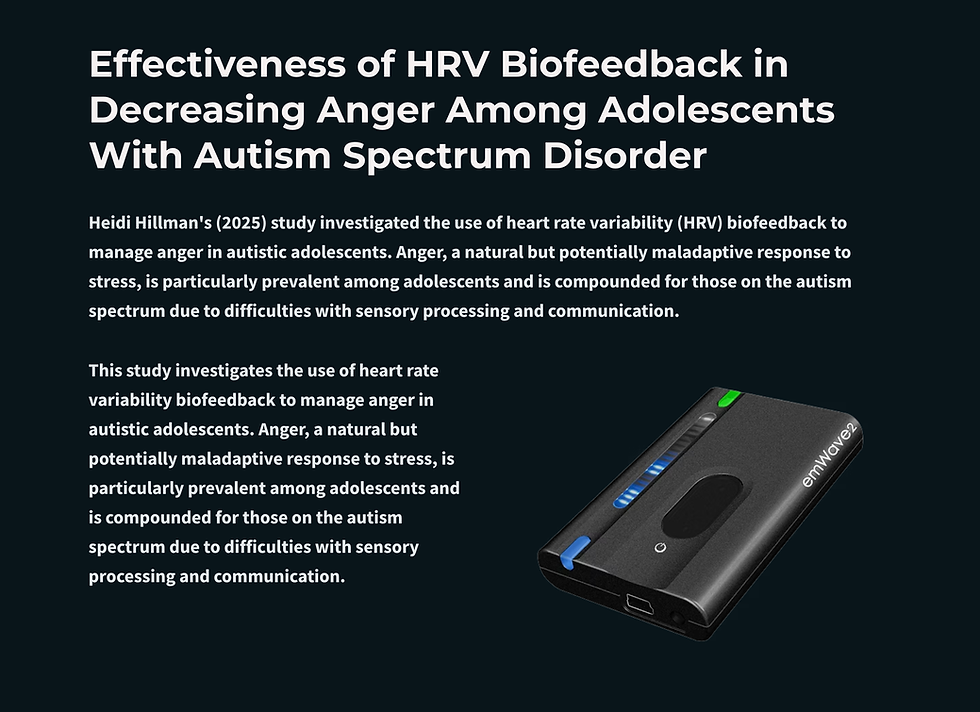
Who Is Dr. Heidi Hillman?

What Are The Challenges of Adolescents With ASD?
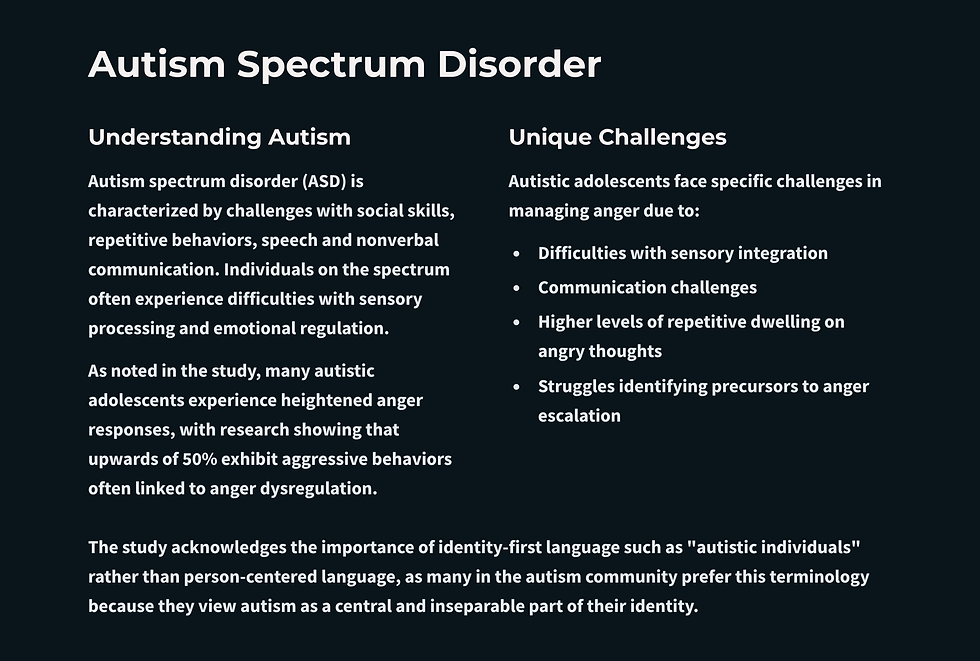
How Did They Do It?

What Did They Find?
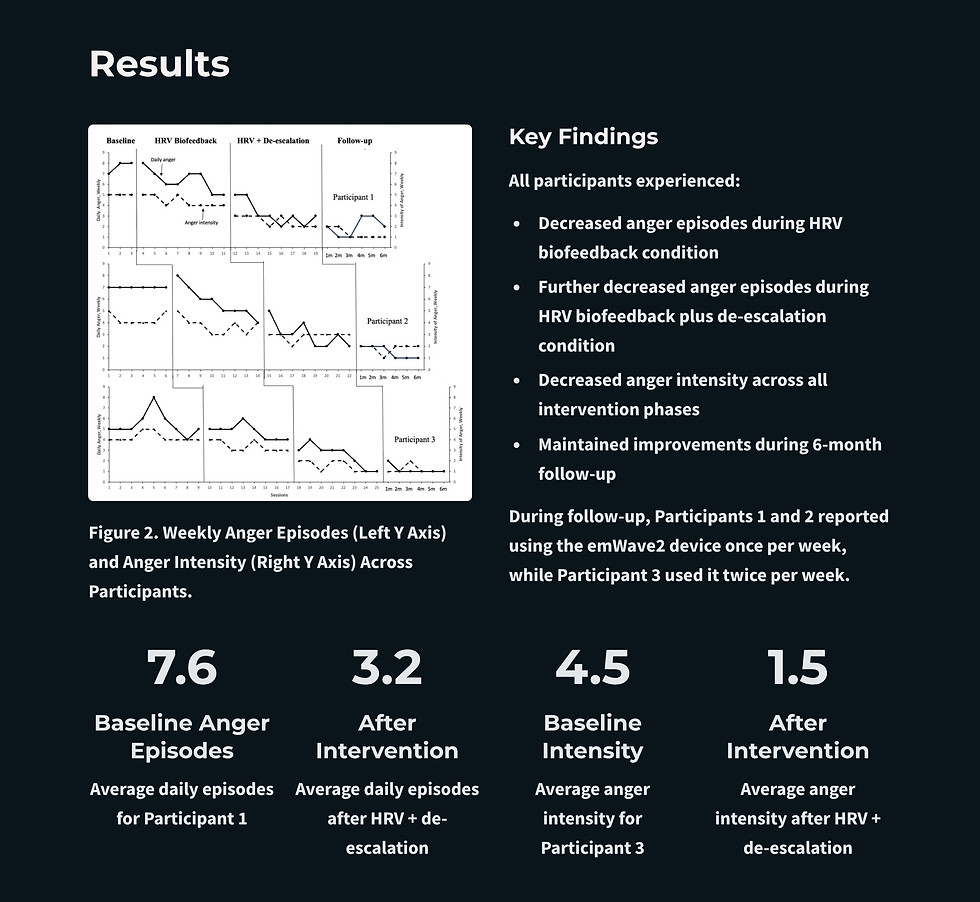
What Was The Impact?
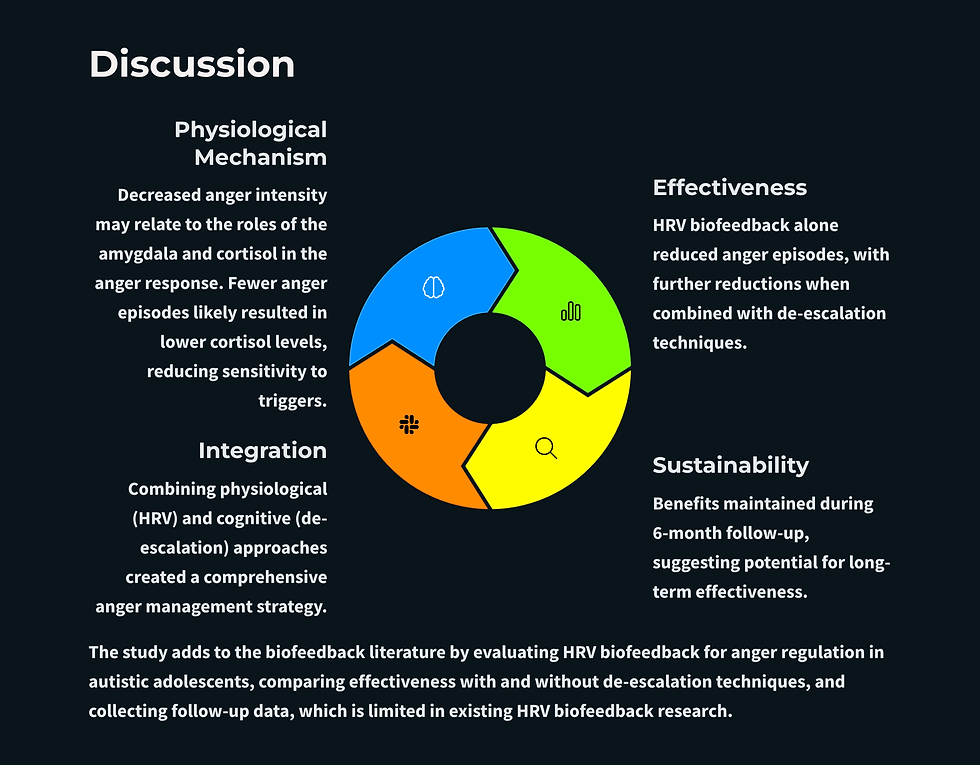
What Were The Study's Strengths and Weaknesses?
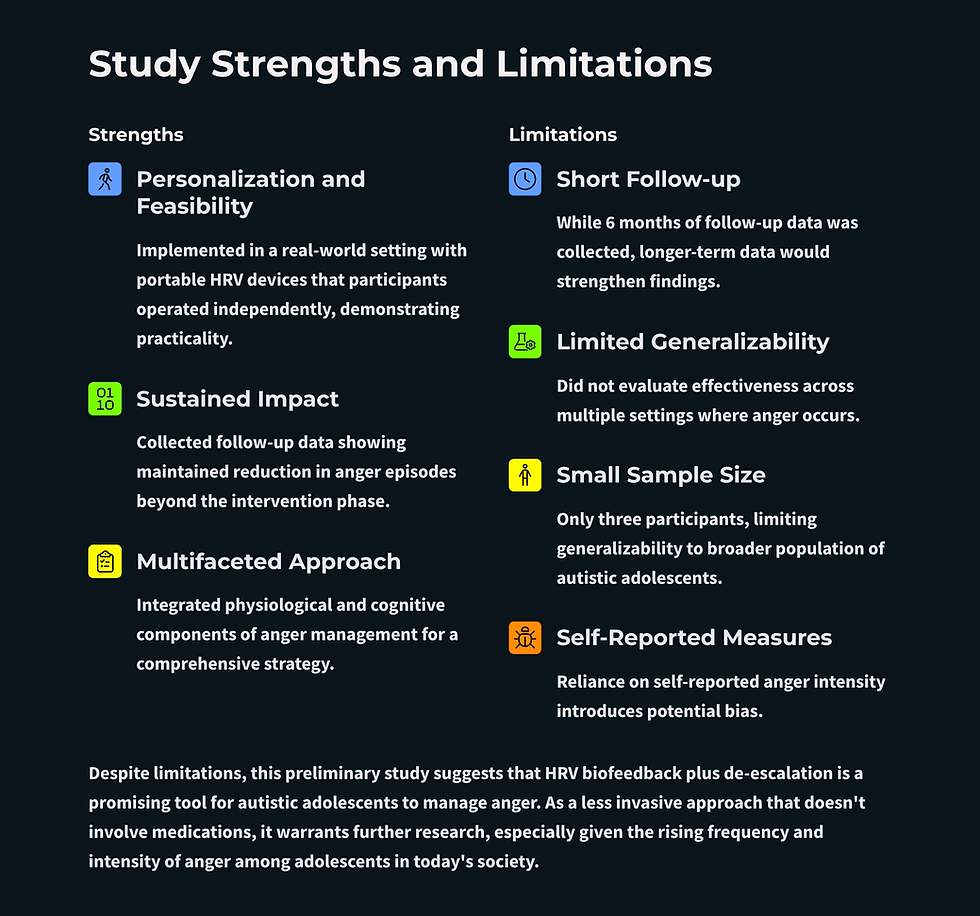
Glossary
acceptance-based interventions: therapeutic strategies that encourage individuals to acknowledge and accept their emotional states without judgment, often used to reduce resistance and promote adaptive coping.
alexithymia: a subclinical condition characterized by difficulty identifying and describing one’s own emotions, commonly observed in individuals with autism and associated with impaired emotional regulation.
amygdala: a limbic brain structure involved in processing emotions, particularly fear and anger; initiates autonomic and endocrine responses to perceived threats.
anger dysregulation: a pattern of excessive, frequent, or poorly controlled anger responses that interfere with social, academic, or emotional functioning.
anxiety: a state of heightened arousal, vigilance, or apprehension often linked with increased sympathetic nervous system activity and reduced HRV.
applied behavior analysis (ABA): a scientific discipline focused on applying principles of learning and behavior to improve socially significant behaviors, often used in autism interventions.
autism spectrum disorder (ASD): a neurodevelopmental condition marked by persistent difficulties in social interaction, communication, and the presence of restricted or repetitive behaviors, with wide variability in symptoms and functioning.
autonomic nervous system (ANS): a branch of the peripheral nervous system responsible for involuntary physiological functions, comprising the sympathetic and parasympathetic divisions.
behavioral activation: a therapeutic strategy aimed at increasing engagement in meaningful activities to counter negative emotions and reduce avoidance behaviors.
cognitive-behavioral strategies: techniques that modify dysfunctional thoughts and behaviors, often through skills training, exposure, and cognitive restructuring.
cortisol: a glucocorticoid hormone released by the adrenal cortex in response to stress; chronically elevated levels impair emotional regulation and increase sensitivity to threats.
de-escalation: a deliberate process of reducing emotional arousal and behavioral intensity, typically through calming techniques and environmental disengagement.
electrodermal activity (EDA): a measure of skin conductance that reflects sympathetic nervous system activity, used in some biofeedback applications.
emotion regulation: the ability to monitor, evaluate, and modify emotional responses, especially in terms of intensity and duration, to achieve goals or meet situational demands.
EmWave2: a portable HRV biofeedback device developed by HeartMath that uses photoplethysmography (PPG) via an ear clip to measure heart rhythm and coherence.
follow-up phase: a post-intervention monitoring period used to assess whether treatment gains are sustained after formal training has ended.
generalization: the transfer of learned skills or behaviors across different settings, people, or situations outside of the original training context.
heart rate variability (HRV): the fluctuation in time intervals between consecutive heartbeats, reflecting autonomic nervous system balance and stress resilience.
HPA axis (hypothalamic-pituitary-adrenal axis): a neuroendocrine system that regulates stress responses via the release of cortisol; frequently overactive in individuals with chronic emotional dysregulation.
imagery: A cognitive strategy involving visualization of calming or positive scenarios to reduce stress and redirect attention during emotional arousal.
interoceptive awareness: the ability to perceive and interpret internal bodily sensations, such as heart rate or respiration, which plays a key role in emotional awareness and regulation.
Likert scale: A psychometric scale commonly used for self-report, where participants rate their feelings or perceptions on a continuum (e.g., from 1 = calm to 5 = very angry).
metacognitive insight: awareness and understanding of one’s own thought processes, including the capacity to recognize and intervene in emotional reactions.
multiple baseline design: a type of single-case experimental design where the intervention is introduced at different times across subjects or behaviors to demonstrate treatment effects while controlling for time-based confounds.
neurodivergent: A term describing individuals whose neurological functioning diverges from typical norms, often used to describe conditions such as autism, ADHD, or dyslexia.
parasympathetic nervous system: the division of the autonomic nervous system associated with rest, digestion, and recovery; increases HRV and promotes calming effects.
photoplethysmography (PPG): a noninvasive optical method used to detect blood volume changes in the microvascular bed of tissue, often used to estimate HRV.
resonance frequency breathing: a breathing pattern (typically around 6 breaths per minute) that maximizes HRV and baroreflex efficiency, often taught in HRV biofeedback protocols.
self-report measure: a data collection method in which participants rate or describe their own behaviors, thoughts, or feelings, commonly used in psychological assessments.
single-case design: a research methodology that focuses on the individual as the unit of analysis, often used in applied settings to demonstrate intervention effects through repeated measurement.
sympathetic nervous system: the branch of the autonomic nervous system responsible for the body’s fight-or-flight response; typically increases heart rate and reduces HRV.
vagal tone: a measure of the activity of the vagus nerve, which regulates parasympathetic output; higher vagal tone is associated with improved emotional and physiological regulation.
Reference
Hillman, H. (2025). Effectiveness of HRV biofeedback in decreasing anger among adolescents with autism spectrum disorder. NeuroRegulation, 12(1), 79–85. https://doi.org/10.15540/nr.12.1.79

Mentor GPT now references Evidence-Based Practice in Biofeedback and Neurofeedback (4th ed.) when you inquire about efficacy. In contrast, Wikipedia uses 15-year-old ratings that greatly understate biofeedback and neurofeedback effectiveness for conditions like ADHD, asthma, depression, and erectile dysfunction. We're trying to persuade a moderator to accept our edits.
Please let us know how we can improve Mentor's answers. Send us your discussion thread by clicking on the Share icon at the top right corner of your screen and email us what you wanted Mentor to say.
We update Mentor's knowledge base throughout the week to make it more valuable for you.
Support Our Friends

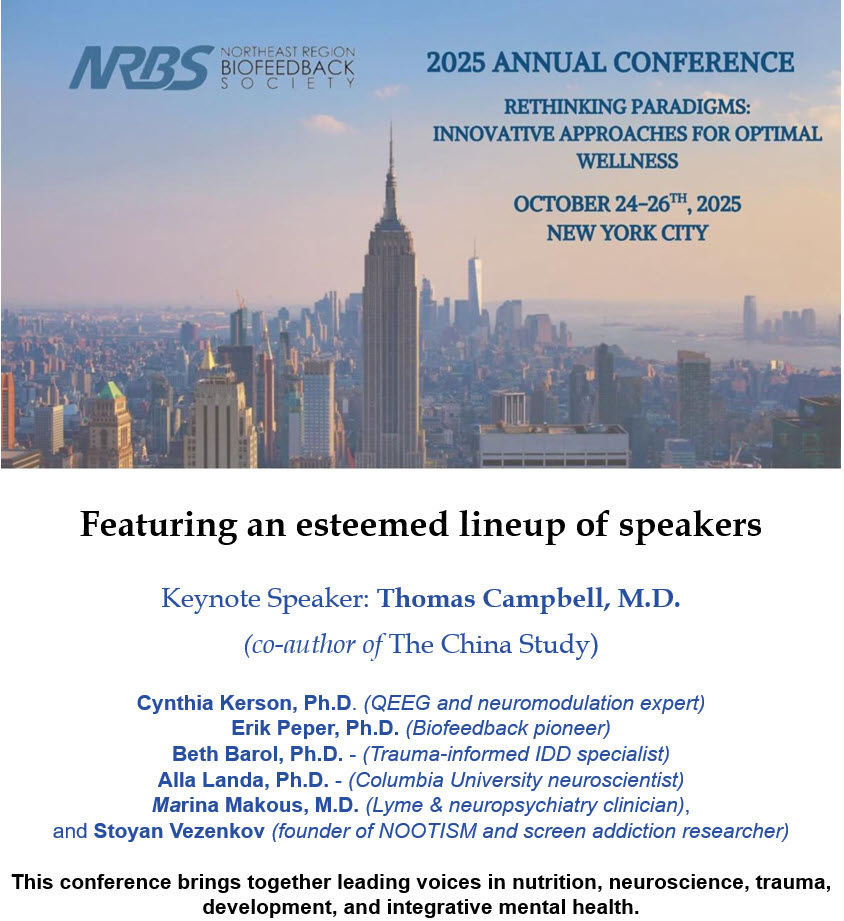







Comments